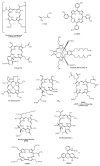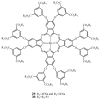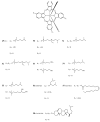Like a bolt from the blue: phthalocyanines in biomedical optics
- PMID: 22198535
- PMCID: PMC6269082
- DOI: 10.3390/molecules17010098
Like a bolt from the blue: phthalocyanines in biomedical optics
Abstract
The purpose of this review is to compile preclinical and clinical results on phthalocyanines (Pcs) as photosensitizers (PS) for Photodynamic Therapy (PDT) and contrast agents for fluorescence imaging. Indeed, Pcs are excellent candidates in these fields due to their strong absorbance in the NIR region and high chemical and photo-stability. In particular, this is mostly relevant for their in vivo activation in deeper tissular regions. However, most Pcs present two major limitations, i.e., a strong tendency to aggregate and a low water-solubility. In order to overcome these issues, both chemical tuning and pharmaceutical formulation combined with tumor targeting strategies were applied. These aspects will be developed in this review for the most extensively studied Pcs during the last 25 years, i.e., aluminium-, zinc- and silicon-based Pcs.
Figures

















Similar articles
-
Improved photodynamic efficacy of Zn(II) phthalocyanines via glycerol substitution.PLoS One. 2014 May 19;9(5):e97894. doi: 10.1371/journal.pone.0097894. eCollection 2014. PLoS One. 2014. PMID: 24840576 Free PMC article.
-
Zn phthalocyanines loaded into liposomes: Characterization and enhanced performance of photodynamic activity on glioblastoma cells.Bioorg Med Chem. 2020 Apr 1;28(7):115355. doi: 10.1016/j.bmc.2020.115355. Epub 2020 Feb 5. Bioorg Med Chem. 2020. PMID: 32067893
-
cis-Silicon phthalocyanine conformation endows J-aggregated nanosphere with unique near-infrared absorbance and fluorescence enhancement: a tumor sensitive phototheranostic agent with deep tissue penetrating ability.J Mater Chem B. 2020 Apr 8;8(14):2895-2908. doi: 10.1039/d0tb00192a. J Mater Chem B. 2020. PMID: 32195527
-
Targeting Cancer Cells with Photoactive Silica Nanoparticles.Curr Pharm Des. 2016;22(39):6021-6038. doi: 10.2174/1381612822666160614083804. Curr Pharm Des. 2016. PMID: 27306094 Review.
-
The unique features and promises of phthalocyanines as advanced photosensitisers for photodynamic therapy of cancer.Chem Soc Rev. 2020 Feb 21;49(4):1041-1056. doi: 10.1039/c9cs00129h. Epub 2019 Dec 17. Chem Soc Rev. 2020. PMID: 31845688 Review.
Cited by
-
On the remarkable nonlinear optical properties of natural tomato lycopene.Sci Rep. 2022 May 31;12(1):9078. doi: 10.1038/s41598-022-12196-3. Sci Rep. 2022. PMID: 35641580 Free PMC article.
-
Application of Asymmetrical Flow Field-Flow Fractionation for Characterizing the Size and Drug Release Kinetics of Theranostic Lipid Nanovesicles.Int J Mol Sci. 2021 Sep 28;22(19):10456. doi: 10.3390/ijms221910456. Int J Mol Sci. 2021. PMID: 34638795 Free PMC article.
-
Antimicrobial Photodynamic Therapy against Escherichia coli and Staphylococcus aureus Using Nanoemulsion-Encapsulated Zinc Phthalocyanine.Microorganisms. 2023 Apr 27;11(5):1143. doi: 10.3390/microorganisms11051143. Microorganisms. 2023. PMID: 37317117 Free PMC article.
-
Photodynamic therapy for prostate cancer: Recent advances, challenges and opportunities.Front Oncol. 2022 Sep 23;12:980239. doi: 10.3389/fonc.2022.980239. eCollection 2022. Front Oncol. 2022. PMID: 36212416 Free PMC article. Review.
-
Improved photodynamic efficacy of Zn(II) phthalocyanines via glycerol substitution.PLoS One. 2014 May 19;9(5):e97894. doi: 10.1371/journal.pone.0097894. eCollection 2014. PLoS One. 2014. PMID: 24840576 Free PMC article.
References
-
- McKeown N.B. The synthesis of symmetrical phthalocyanines. In: Kadish K.M., Smith K.M., Guilard R., editors. The Porphyrin Handbook. Academic Press; San Diego, CA, USA: 2003. pp. 61–124.
-
- Thomas A.L. Phthalocyanine Research and Applications. CRC Press; Baton Rouge, FL, USA: 1990. p. 2.
-
- McKeown N.B. An introduction to the phthalocyanines. In: McKeown N.B., editor. Phthalocyanine Materials: Synthesis, Structure and Function. Cambridge University Press; Cambridge, UK: 1998. pp. 1–10.
-
- Geng Y.Y., Gu D.H., Wu Y.Q., Gan F.X. High speed recording property of phthalocyanine thin film for compact disc recordable. Proc. SPIE Int. Soc. Opt. Eng. 2003;63:63–66.
-
- Petritsch K., Friend R.H., Lux A., Rozenberg G., Moratti S.C., Holmes A.B. Liquid crystalline phthalocyanines in organic solar cells. Synth. Met. 1999;102:1776–1777.
Publication types
MeSH terms
Substances
LinkOut - more resources
Full Text Sources
Other Literature Sources
Miscellaneous

